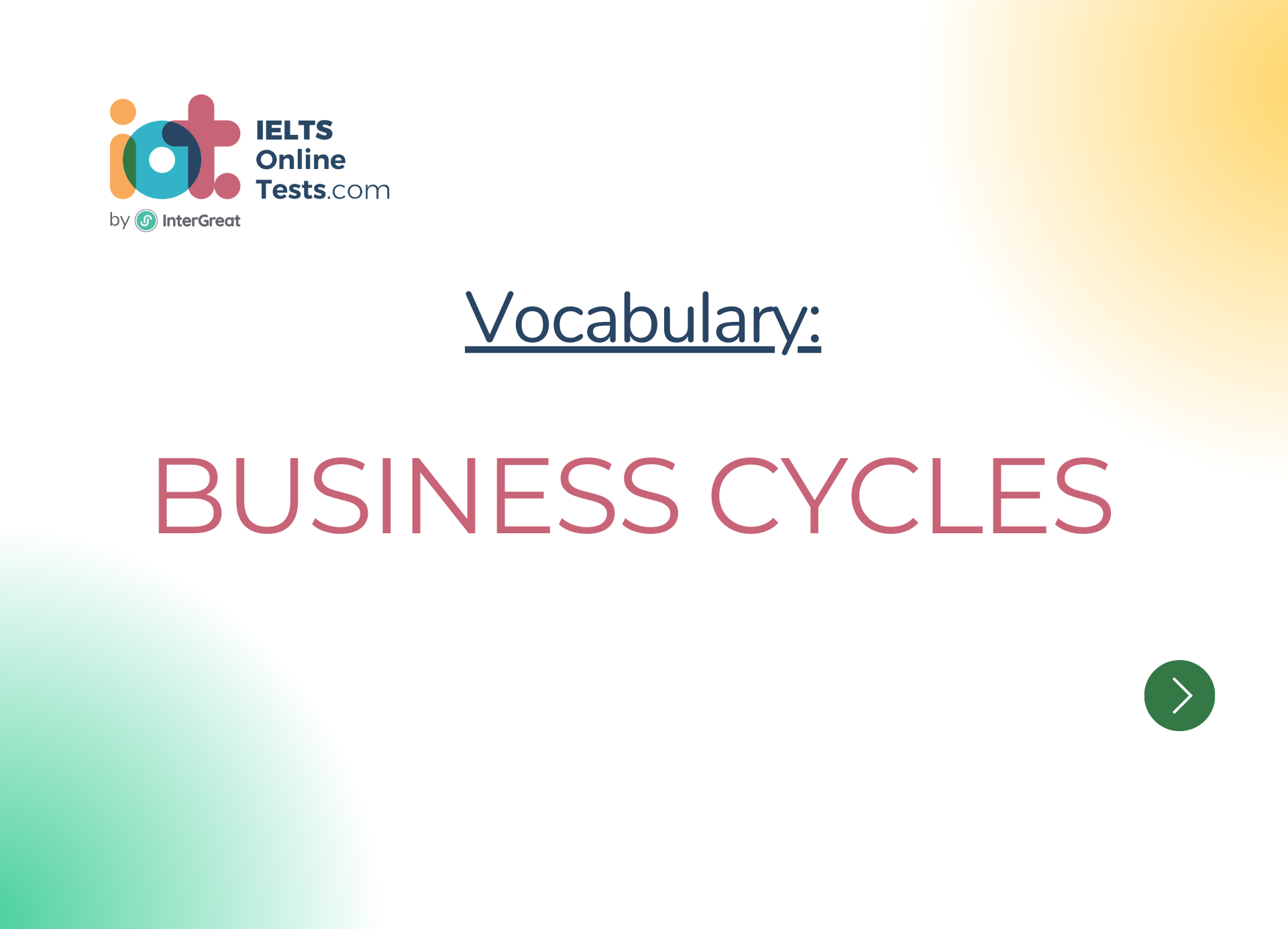
Business cycles
Here are some vocabulary words related to business cycles for IELTS band scores 4.5-6.0:
Business Cycle:
The natural fluctuation of economic activity between periods of expansion and contraction.
Expansion:
A phase in the business cycle characterized by economic growth, increased production, and rising employment.
Boom:
An extended period of rapid economic growth and high levels of economic activity.
Peak:
The highest point in the business cycle when economic activity is at its maximum before entering a downturn.
Contraction:
A phase in the business cycle characterized by a slowdown in economic activity, declining production, and rising unemployment.
Recession:
A significant decline in economic activity, lasting for a prolonged period, usually measured by two consecutive quarters of negative GDP growth.
Trough:
The lowest point in the business cycle when economic activity is at its lowest before starting to recover.
Recovery:
The phase in the business cycle when economic activity starts to pick up after a recession or contraction.
Cyclical Industries:
Industries whose performance and revenues are highly sensitive to changes in the business cycle.
Countercyclical:
Refers to economic factors that move in the opposite direction of the overall business cycle.
Procyclical:
Economic factors that move in the same direction as the overall business cycle.
Economic Indicator:
A statistic or data point used to gauge the overall health and direction of an economy, such as GDP, unemployment rate, or consumer confidence.
Gross Domestic Product (GDP):
The total value of all goods and services produced within a country's borders in a specific time period.
Unemployment Rate:
The percentage of the labor force that is unemployed and actively seeking employment.
Consumer Confidence:
An economic indicator that measures the degree of optimism that consumers feel about the overall state of the economy.
Inflation Rate:
The percentage increase in the general price level of goods and services over a specific period.
Deflation:
A sustained decrease in the general price level of goods and services, often leading to reduced consumer spending.
Stagflation:
A situation where an economy experiences stagnant economic growth, high unemployment, and high inflation simultaneously.
Interest Rate:
The cost of borrowing money or the return on investment, set by the central bank or determined by market forces.
Monetary Policy:
The use of interest rates and money supply by the central bank to control inflation and stabilize the economy.
Fiscal Policy:
The use of government spending and taxation to influence the economy, often to stabilize business cycles.
Government Spending:
The total expenditures made by the government on goods, services, and investment.
Budget Deficit:
Occurs when government spending exceeds its revenue and must borrow to cover the shortfall.
Budget Surplus:
Occurs when government revenue exceeds its spending, resulting in excess funds.
Public Debt:
The total amount of money that a government owes to external creditors and internal bondholders.
Aggregate Demand:
The total demand for goods and services in an economy at a given price level and time.
Aggregate Supply:
The total supply of goods and services in an economy at a given price level and time.
Business Investment:
Spending by businesses on capital goods such as machinery, equipment, and buildings.
Consumer Spending:
Expenditures made by individuals on goods and services for personal use.
Economic Growth:
An increase in the output of goods and services produced by an economy over time.
Business Confidence:
A measure of how optimistic businesses are about the future state of the economy.
Productivity:
The efficiency with which inputs (such as labor and capital) are used to produce goods and services.
Labor Force:
The total number of people who are willing and able to work in an economy.
Labor Market:
The market in which workers find jobs and employers find workers.
Inflationary Pressure:
Factors that contribute to a rise in the general price level of goods and services.
Wage Growth:
The increase in wages or salaries earned by workers over time.
Economic Downturn:
A period of reduced economic activity characterized by declining GDP and increased unemployment.
Economic Upturn:
A period of increased economic activity characterized by rising GDP and decreased unemployment.
Economic Recovery:
The phase following a downturn when the economy starts to grow again.
Demand-pull Inflation:
Inflation that occurs when aggregate demand exceeds aggregate supply.
Understanding these business cycle-related terms will help you discuss economic trends and fluctuations, demonstrating a deeper level of vocabulary and comprehension for the IELTS exam. Keep practicing and incorporating these words into your writing and speaking to enhance your language skills. Good luck with your studies!




